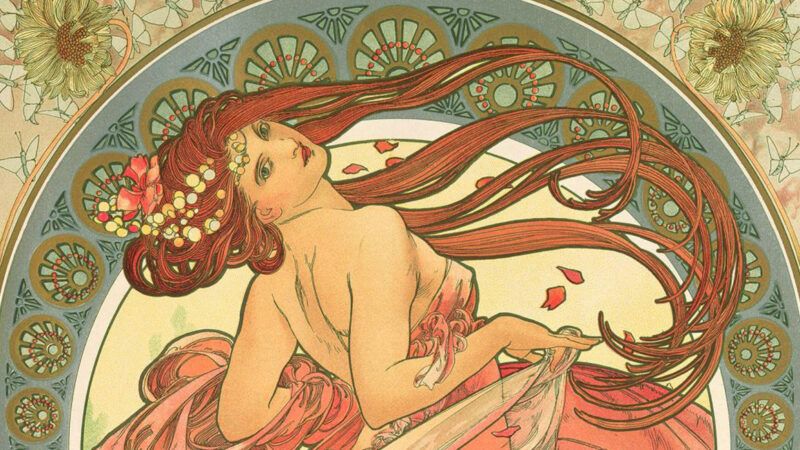Review: Blurring the Line Between Fine Art and Advertising
Commercial genius Alphonse Mucha's ads helped sell everything from soap to Champagne.

The "Timeless Mucha" exhibition at The Phillips Collection in Washington, D.C., (February 22–May 18, 2025) is a luxurious look at Alphonse Mucha's commercial genius. Best known for his decorative posters of actresses, the art nouveau master blurred the line between fine art and advertising.
The show makes the case that Mucha's commercial output wasn't a sideline—it was the core of his legacy. With elegant linework, stylized florals, and idealized humanity, Mucha sold everything from soap to Champagne, and in doing so he shaped the visual language of a generation. The Moravian artist provided a visual vocabulary for the world's many bohemians.
The exhibition documents both his artistic ambition and his popular reach, and it makes a convincing case that his work was riskier and grittier in his own time than it feels in ours. "Timeless Mucha" proves that beauty and branding don't have to be at odds.
Editor's Note: As of February 29, 2024, commenting privileges on reason.com posts are limited to Reason Plus subscribers. Past commenters are grandfathered in for a temporary period. Subscribe here to preserve your ability to comment. Your Reason Plus subscription also gives you an ad-free version of reason.com, along with full access to the digital edition and archives of Reason magazine. We request that comments be civil and on-topic. We do not moderate or assume any responsibility for comments, which are owned by the readers who post them. Comments do not represent the views of reason.com or Reason Foundation. We reserve the right to delete any comment and ban commenters for any reason at any time. Comments may only be edited within 5 minutes of posting. Report abuses.
Please to post comments


Would that the world learned the lesson behind this
Martin Luther King Jr. — 'If a man is called to be a street sweeper, he should sweep streets even as a Michaelangelo painted, or Beethoven composed music...
And he Jewish wisdom of Ecclesiastes
Whatever your hand finds to do, do it with all your might
Free advertising.
There never was any difference between fine art and commercial art. The writer seems to subscribe to the idea of blurring a non-existent line. There is only good art and bad art and the many shades between - and even that is an opinion not a true line. There is also decoration versus lyrical versus abstract art and all the gradations there. "I like it" is the only thing that matters.
The writer is also the EIC. There's a reason nobody's here to read her nonsense. She's made Reason into Clown Town.
"I like it" is the only thing that matters.
That is the absolute last thing that matters.
Beauty is as objective as anything else. The aesthetic is as real and measurable as the physical, logical, or mathematical.
https://www.youtube.com/watch?v=lNI07egoefc
Standards vs Relativism. Pretty much sums it up.
If you like it, and "it" is garbage - then there is something wrong with your ability to understand and comprehend what it is you're seeing. (And his example of figure skating is a perfect illustration of this.)
You just destroyed 'acquired taste" The most expensive wine in the world will be spit out by a child
If you don't think there's a difference, then you don't really understand advertising, PR, marketing, and all the other stuff of 'commercial' art. Maybe before WW1 or so they merge into the same thing because not much was understood about motivation, manipulation, how the brain works, psychology, etc. But WW1 marks a very obvious transition. The work of Freud, Bernays, Hopkins, Lippmann, Packard, and many later show how systematic and even scientific the commercial purposes have become. Art itself had a reaction but it was to become divided between 'anti-commercial' and 'commercial'. As did music. For many, the anti-commercial is jarring and ugly. But that is partially the point - as a demonstration that 'what we like' may be more manipulated than we want to believe.
Alphonse Mucha’nın eserleri gerçekten zamansız; özellikle Art Nouveau tarzı bugün bile dijital sanatçılara ilham veriyor. Estetik anlayışı değişse de, onun detaylara verdiği önem hâlâ etkileyici. Sanat ve teknoloji birleşince ortaya ilginç şeyler çıkıyor. Mesela mobilde hem görsel hem de kullanıcı deneyimi açısından şık olan platformlar çoğalıyor. bizbet download türkiye gibi siteler, sadece işlevselliği değil aynı zamanda tasarımı da önemsiyor. Bu da Mucha’nın “güzellik ve fayda bir arada olabilir” anlayışıyla örtüşüyor.